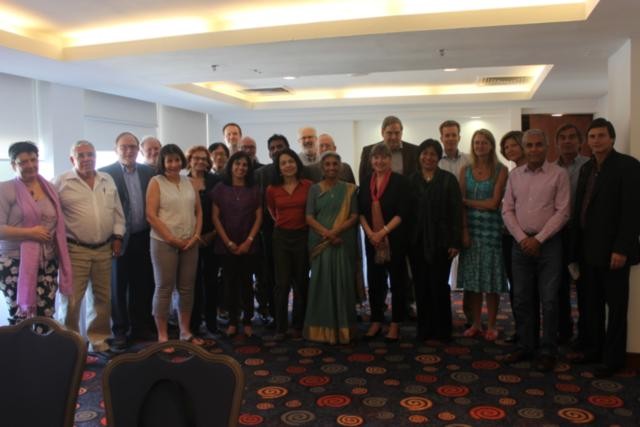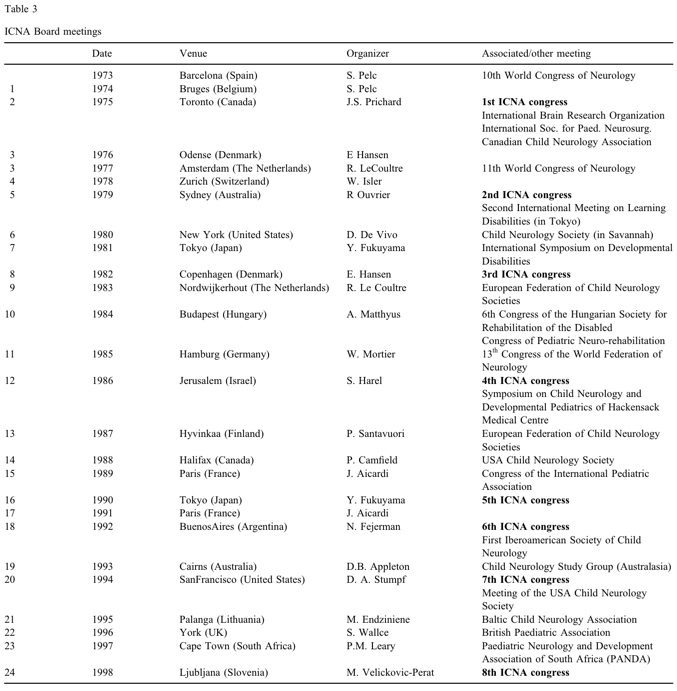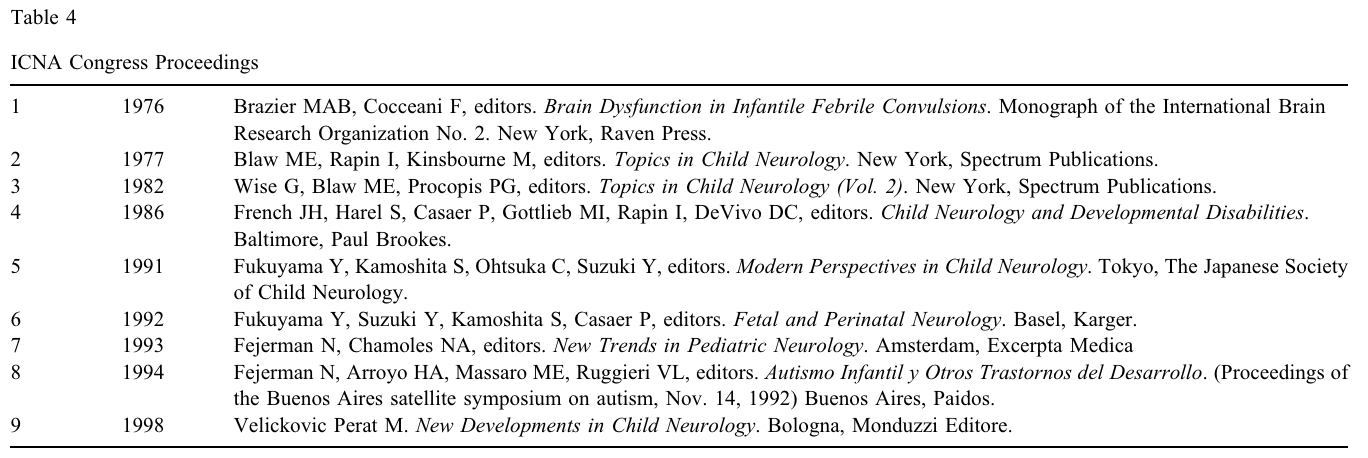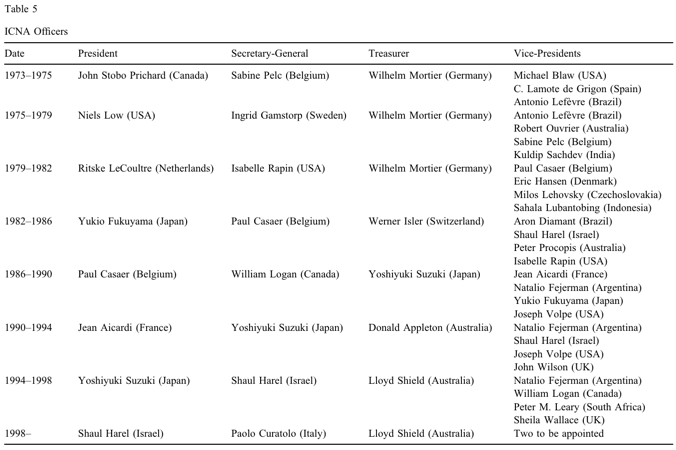-
ICNA Constitution and Bylaws
The Constitution and By-Laws of ICNA state that its reason for being is to improve the quality of the care of children with neurologic disorders by promoting clinical and scientific research in child neurology, encouraging a high training qualification of child neurologists, and providing a medium for international communication amongst child neurologists and members of allied professions, in particular by organizing international congresses every 2 years. The Constitution and Bylaws were last amended on 8 May 2024 at the AGM held in Cape Town, South Africa.
-
ICNA Executive Board 2010-2014
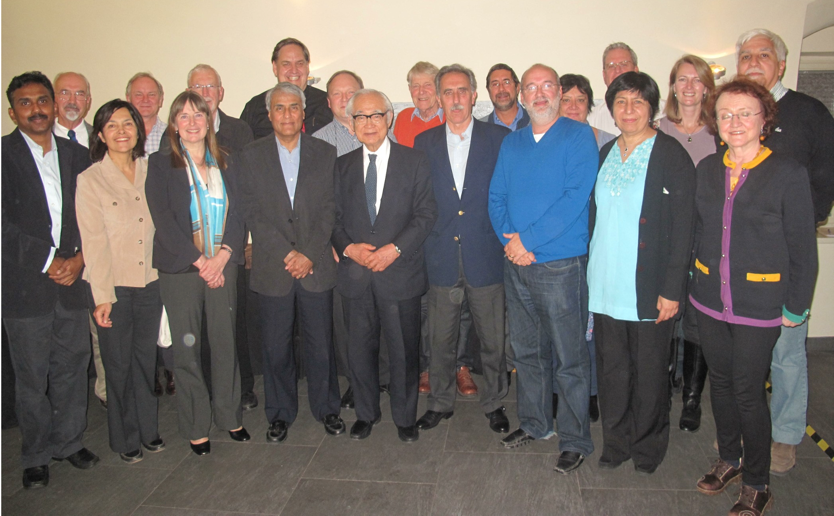 ICNA Executive Board 2010-2014. From left to right: Biju Hameed (coopted), Robert Rust, Banu Anlar, Charles Newton, Ingrid Tein, Robert Ouvrier, Harry Chugani, Kenneth Mack, Lieven Lagae, Masaya Segawa, Orvar Eeg-Olofsson, Hugo Arroyo, Paolo Curatolo, Michael Shevell, Linda De Meirler, Andre Venter, Pratibha Singhi, Jo Wilmshurst, Raili Riikonen, Guillermo Agosta. Missing from the photo are Yong-Seung Hwang, Andrew Kornberg, Takao Takahashi, Virginia Wong, Ahmed Raouf Ibrahim, Vijeya Ganesan.
ICNA Executive Board 2010-2014. From left to right: Biju Hameed (coopted), Robert Rust, Banu Anlar, Charles Newton, Ingrid Tein, Robert Ouvrier, Harry Chugani, Kenneth Mack, Lieven Lagae, Masaya Segawa, Orvar Eeg-Olofsson, Hugo Arroyo, Paolo Curatolo, Michael Shevell, Linda De Meirler, Andre Venter, Pratibha Singhi, Jo Wilmshurst, Raili Riikonen, Guillermo Agosta. Missing from the photo are Yong-Seung Hwang, Andrew Kornberg, Takao Takahashi, Virginia Wong, Ahmed Raouf Ibrahim, Vijeya Ganesan.2010-2014
President: Harry Chugani
Secretary-General: Jo Wilmshurst
Treasurer: Lieven Lagae
Board Members
Ahmed Raouf Ibrahim
Andre Venter
Linda De Meirleir
Andrew Kornberg
Masaya Segawa
Banu Anlar Michael Shevell
Biju Hameed (coopted)
Orvar Eeg-Olofsson
Charles Newton
Paolo Curatolo
Guillermo Agosta
Pratibha Singhi
Raili Riikonen
Hugo Arroyo
Robert Ouvrier
Ingrid Tein
Robert Rust
Takao Takahashi
Kenneth Mac
Vijeya Ganesan
Virgnina Wong
Yong-Seung Hwang -
ICNA Executive Board 2014-2018
ICNA Executive Board 2014 - 2018.
-
ICNA Executive Board 2018 - 2022
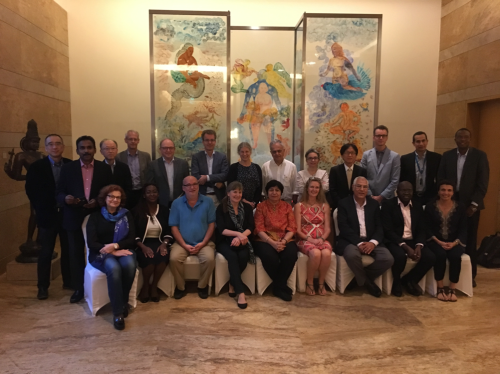
The ICNA Executive Board 2018 - 2022.
-
ICNA Officers and Executive Board
The International Child Neurology Association (ICNA) was founded to provide a global forum for neurologists dedicated to the care of children with neurological conditions. The ICNA Executive Board members current and past are listed below.
-
The International Child Neurology Association: the first 25 years
Birth of child neurology in different parts of the world
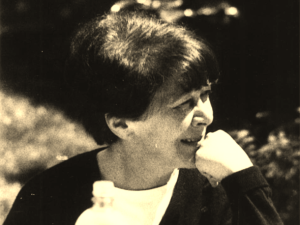 Sabine Pelc, MD, born in Czeshachoma, Poland in 1921, graduated in 1950 from the medical school of the Free University of Brussels, died in Brussels in 1989In the late 1960s, a child neurologist from the Free University of Brussels, Belgium, Dr. Sabine Pelc (1921–1989), (Fig. 1), perceived the need for a world-wide forum for neurologists whose focus was the care of children with neurologic conditions. In order to fill this need, she set about visiting various European and American countries in order to identify other child neurologists. I met her in 1969 when she visited the Neurological Institute of Columbia Presbyterian Medical Center in New York, where the National Institute of Neurologic Diseases and Blindness of the National Institutes of Health (NIH) had supported a training program for child neurologists since 1956 under the directorship of Dr. Sidney Carter. She had already identified a number of fully trained child neurologists in Europe, Japan and Latin America before coming to the USA.
Sabine Pelc, MD, born in Czeshachoma, Poland in 1921, graduated in 1950 from the medical school of the Free University of Brussels, died in Brussels in 1989In the late 1960s, a child neurologist from the Free University of Brussels, Belgium, Dr. Sabine Pelc (1921–1989), (Fig. 1), perceived the need for a world-wide forum for neurologists whose focus was the care of children with neurologic conditions. In order to fill this need, she set about visiting various European and American countries in order to identify other child neurologists. I met her in 1969 when she visited the Neurological Institute of Columbia Presbyterian Medical Center in New York, where the National Institute of Neurologic Diseases and Blindness of the National Institutes of Health (NIH) had supported a training program for child neurologists since 1956 under the directorship of Dr. Sidney Carter. She had already identified a number of fully trained child neurologists in Europe, Japan and Latin America before coming to the USA.In the United States, the NIH had recognized the need for physicians specially trained in the neurology of childhood in the mid-1950s, a decade after neurology had become a spe-cialty, independent from both psychiatry and internal medicine, and after neurology residency training programs had been established in major medical schools. Up to the mid-1950s, there were no official training programs in child neurology in the USA. Most children with neurologic diseases were cared for by pediatricians or orthopedists interested in cerebral palsy, by adult neurologists interested in epilepsy, or by neurosurgeons who, besides children with brain tumors, hydrocephalus, or cranio-cerebral injuries, often treated those with medical neurologic problems. The level of care was uneven and there was little research on the neurologic diseases of children.
In 1956, there were less than a dozen full-time professors of child neurology and training was haphazard. For example, when the need for specialized care for children with neurologic conditions became evident in the early fifties, Dr. H. Houston Merritt, director of the Neurological Institute of New York, put Dr. Sidney Carter, an adult neurologist, in charge of the children’s service, which had been started in 1934 by Dr. Bernard Sachs. Besides Dr. Carter, some of the pioneers in child neurology in the United States included Drs. Frank R. Ford and David B. Clark at Johns Hopkins Medical School in Baltimore.
In 1937, Dr. Ford wrote a classic textbook of child neurology that went through six editions. At Boston Children’s Hospital, Dr. Bronson Crothers founded child neurology in 1920 and was soon joined by Dr. Randolph Byers. The 1959 Crothers and Paine’s monograph on cerebral palsy remains a classic to this day. At the Massachusetts General Hospital in Boston, Dr. Philip R. Dodge assisted Dr. Raymond D. Adams, a celebrated professor of neurology and neuropathology, in running the child neurology service until he moved to St Louis in 1967 to spawn another school of child neurologists. At the University of Chicago, Dr. Douglas Buchanan, a Scot, joined the neurosurgeon Paul Bucy in 1931.
As a medical student in Switzer-land in 1948, I devoured their 1939 book, written in collaboration with the neurosurgeon and neuropathologist Dr. Percival Bailey, which provides case histories of 100 consecutive intracranial tumors in children; this exciting book made me aware of the attractions of child neurology and contributed to my unswerving decision to become a child neurologist after I attended Dr. Ste´phane Thieffry’s teaching consultations in child neurology at the Hoˆpital des Enfants Malades in Paris in 1951.
By 1954, when I became a resident in neurology at the Neurological Institute, Dr. Carter had already trained one child neurologist, Dr. Marvin Lewis, who unfortunately had just died of a malignancy. Dr. Niels Low, then a pediatrician and a future president of ICNA, came to the Neurological Institute in January 1955. He spent a year of training with Dr. Carter, went to Salt Lake City as a child neurologist (where in 1956 he showed me a ward of untreated adolescents with phenylketonuria) and returned to New York in July 1958 to complete his training in neurology and become eligible for the Board Examination in Neurology, which he and I (3 days from delivering my second daughter) took together in a major snowstorm in December 1960.
From 1956 on, support from the NIH enabled Dr. Carter to train two child neurologists every year, and other medical schools with major neurology services to develop their training programs in child neurology. By 1967, the American Board of Psychiatry and Neurology and American Board of Pediatrics had established criteria for eligibility for the dual Board Examinations in Pediatrics and in Neurology with Special Competence in Child Neurology. The criteria were 2 years of pediatrics, 1 year of adult neurology, and 2 years of child neurology to include a year of clinical hospital in- and out-patient work and a year combining further clinical work with such electives as EEG, neuroimaging, neuropathology, or research.
By 1970, the number of fully trained and qualified child neurologists in the USA and Canada was large enough for them to feel the need for their own society. The Child Neu-rology Society (CNS) was founded at its first meeting in Hamilton, Ontario in 1972 under the presidency of Dr. Ken-neth Swaiman, also one of the founding members of the ICNA. At its inception, the CNS had 223 members; it celebrated its 25th anniversary in 1997 and its membership in 1998 is 1290.
In Canada Dr. J Preston Robb was in charge of neurology at the Children’s Hospital of Montreal and collaborated with Dr. Wilder Penfield in epilepsy surgery. His service was the nidus for training a large number of child neurologists, particularly interested in epilepsy and genetic disorders. Dr. John Stobo Prichard (1914–1986), who was born in Wales but emigrated to Toronto in 1950, was the founding president of ICNA. He trained many child neurologists for underdeveloped and commonwealth countries, many of whom developed child neurology services of their own. Another emigrant from the UK, Dr. Henry Dunn, is described as the father of child neurology in British Columbia.
Child neurology was also developing in a number of European countries. In the United Kingdom, Dr. Ronald C. Mac Keith, a pediatrician whose focus was the multi-disciplinary care of children with cerebral palsy, from 1958 on organized bi-yearly meetings of the Spastics Society’s Little Club in Oxford; the meetings were kept relatively small, though international, so as to foster meaningful discussion. These were a first European venue for the meeting of European and American child neurologists; they led to the founding of the European Federation of Child Neurology Societies in 1970, which held the first of its bi-yearly meetings in Sweden in 1973. It was supplanted by the European Pediatric Neurology Society which had its first meeting in Eilat, Israel in 1995. Other pioneers of child neurology in the UK were Dr. Thomas T.S. Ingham of Edinburgh and Dr. Neil Gordon of Cheshire.
In 1958 Dr. Mac Keith started the publication of the Little Club Clinics in Cerebral Palsy, a monograph series that, with volume 61 in 1976, became the Clinics in Developmental Medicine. One of their most recent (1998) books is the second edition of ICNA’s Dr. Jean Aicardi’s textbook Diseases of the Nervous System in Childhood. Also in 1958, Dr. Mac Keith had launched the first volume of the Cerebral Palsy Bulletin which, in 1962, became Developmental Medicine and Child Neurology, one of the major international journals devoted to our specialty.
In Holland Dr. Hans Prechtl, in Germany Dr. Albrecht Peiper, and in France, Dr. Andre´ -Thomas had spearheaded the neurologic examination of neonates, studies that Drs. Claude Dreyfus-Brisac and S Saint-Anne Dargassies were to extend to premature and high risk infants. Besides Dr. Ste´phane Thieffry, and Dr. Gilles Lyon who was to move to Brussels, Dr. Jean Aicardi, another future president of ICNA, was a young child neurologist in Paris in the 1950s; he was to direct the child neurology service at the Hoˆpital des Enfants Malades in Paris for many years and to train scores of child neurologists from around the world.
In Belgium Dr. Ludo van Bogaert had been conducting clinical/pathological studies of CNS diseases of childhood in the Bunge Research Institute in Antwerp. In Brussels Drs. Sabine Pelc and Gilles Lyon practiced and taught clinical child neurology. Dr. Lyon created with his young colleague Dr. Philippe Evrard one of the premier academic child neurology services of Europe at the Cliniques Universitaires St. Luc.
In The Netherlands, the pioneers were, besides Dr. Prechtl, Dr. Jacobus Willemse in Utrecht, Dr. Paul Fleury in Amsterdam and Dr. Ritske LeCoultre in Groningen, the future second president of ICNA whose father-in-law was the famous Swiss–Dutch composer Frank Martin.
In Germany, Dr. F J Schulte was the founding editor of Neuropa¨diatrie in 1969 (which became Neuropediatrics in 1980) to which Drs. Wilhelm Mortier and H. Doose, as well as Dr. Kurt Jellinger from Austria, were early contributors. Other early German child neurologists were Drs. Dieter Schaeffer, Folkar Hanefeld and Gert Jacobi.
In Italy Drs. Giovanni Cavazutti and Maurizio De Negri and in Spain the young Drs. Emilio Fernandez Alvarez and Ignacio Pascual Castroviejo were among the pioneers in our field, as were in Scandinavia Dr. Sven Brandt of Denmark, and Drs. Ingrid Gamstorp and Bengt Hagberg of Sweden. Drs. Hagberg and Aicardi will be remembered, among their many other contributions, for putting Rett syndrome on the map.
In Asia and Oceania Dr. Yukio Fukuyama of Japan, another future president of ICNA, was the chief mover in the development of child neurology. His early interest in the infantile and childhood epilepsies and his description in 1960 of the congenital muscular dystrophy that bears his name led to his appointment as Professor and Chief of the Division of Neurology at the National Children’s Hospital in Tokyo in 1965. Two years later he became Professor and Chairman of the Department of Pediatrics of the Tokyo Women’s Medical College where he trained dozens of future child neurologists for Japan and other Asian countries.
The Tokyo Child Neurology Study Group had been meeting for several years when the Japanese Society of Child Neurology held its first meeting in 1961, with over 1000 members. He spearheaded the founding of the Asian and Oceanian Association of Child Neurology in 1983 in Taipei, organized by one of his former students, Dr. Yu-Zen Shen of Taiwan. Dr. Fukuyama was president of the first two International Symposia on Developmental Disabilities in Tokyo in 1977 and 1979, and founded the Japanese child neurology journal No to Hattatsu in 1969 and the international journal Brain and Development in 1979. Like Dr. Aicardi, Dr. Fukuyama traveled widely throughout the world and played a major role in the development of the international pediatric neurology community. In China, Drs. Zuo Chi-Hua and Wu Xi-Ru organized a training symposium on child neurology in Beijing in 1988.
Dr. Ian Hopkins of Australia, trained by Dr. David Clark, brought child neurology to Australia in the 1960s, as did the late Dr. S.K. Hendarto and Dr. S.M. Lumbantobing to Indonesia and Dr. Pongsakdi Visudhiphan to Thailand. A pediatrician in Bombay, India, Dr. Prabhakar Udani, was a long term student of tuberculosis of the central nervous system and of the consequences of prenatal and postnatal malnutrition on brain development. The founder of child neurology in Israel was the late Dr. Naomi Amir. She created modern in-and out-patient services in the venerable Bikur Cholim Hospital, which later moved to the Shaare Zedek Hospital, both in Jerusalem. She organized satellite neurology clinics in several Arab villages, and started a preschool in the hospital for children with a variety of neurologic handicaps which provided her and her trainees the opportunity for intensive and long-term evaluation of the efficacy of various interventions.
In Latin America, some of the pioneers of child neurology were Drs. Antonio Lefe`vre and Olavo Nery and the younger Drs. Aron Diament and Saul Cypel in Brazil, Dr. Maria Antonietta Rebollo in Uruguay, and Drs. Hector Vazquez and Bernabe Cantlon in Argentina where Dr. Aquiles Gar-eiso had started to practice child neurology in the Hospital de Nin˜os in the 1920s. These pioneers founded child neu-rology societies in each of their countries, as well as a Latin American Society in 1978, which indicates that they had succeeded in training a core of younger colleagues, together with others who returned from training in Europe, the USA or Canada. In Monterrey, Mexico, Dr. Rau´l Caldero´ n Gonza´lez, who had trained with Dr. David Clark in Baltimore in the 1960s, founded a modern neurologic multidisciplinary consultation and rehabilitation center for children with cerebral palsy, learning disabilities, epilepsies and other neurologic problems.
Founding of ICNA, incorporation, by-laws
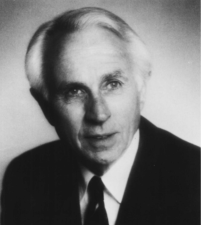 Fig 2. John Stobo Prichard, M.D., born in Barry, Wales in 1914, graduated in medicine from the London Hospital, died in Toronto in 1986Dr. Sabine Pelc, through her travels and correspondence, had assembled a sufficient roster of child neurologists interested in founding an international society to enable them to come together at the 10th Congress of the World Federation of Neurology in Barcelona on September 12, 1973. The founding meeting of ICNA, which 14 attended, was rather tumultuous as there was some confusion about who was invited to the meeting and who was a child neurologist. Among those present, besides Dr. Pelc who was elected Secretary-General, were Dr. John Stobo Prichard from Canada (Fig. 2) who was elected President; from Europe Dr. Wilhelm Mortier from Germany, elected Treasurer, Dr. Ingrid Gamstorp from Sweden, Dr. C LaMote de Grignon from Spain, Dr. Jacobus Willemse from The Netherlands; from Latin America Dr. Rau´l Caldero´n Gonza´lez from Mexico, Dr. Maria Antonietta Rebollo from Uruguay, Dr. Antonio Lefe`vre from Brazil; from Australia Dr. Ian Hopkins; from the USA Drs. Michael Blaw, Niels Low, elected chairman of the Membership Committee, Kenneth Swaiman and Manuel Gomez.
Fig 2. John Stobo Prichard, M.D., born in Barry, Wales in 1914, graduated in medicine from the London Hospital, died in Toronto in 1986Dr. Sabine Pelc, through her travels and correspondence, had assembled a sufficient roster of child neurologists interested in founding an international society to enable them to come together at the 10th Congress of the World Federation of Neurology in Barcelona on September 12, 1973. The founding meeting of ICNA, which 14 attended, was rather tumultuous as there was some confusion about who was invited to the meeting and who was a child neurologist. Among those present, besides Dr. Pelc who was elected Secretary-General, were Dr. John Stobo Prichard from Canada (Fig. 2) who was elected President; from Europe Dr. Wilhelm Mortier from Germany, elected Treasurer, Dr. Ingrid Gamstorp from Sweden, Dr. C LaMote de Grignon from Spain, Dr. Jacobus Willemse from The Netherlands; from Latin America Dr. Rau´l Caldero´n Gonza´lez from Mexico, Dr. Maria Antonietta Rebollo from Uruguay, Dr. Antonio Lefe`vre from Brazil; from Australia Dr. Ian Hopkins; from the USA Drs. Michael Blaw, Niels Low, elected chairman of the Membership Committee, Kenneth Swaiman and Manuel Gomez.The Constitution and By-Laws of ICNA state that its reason for being is to improve the quality of the care of children with neurologic disorders by promoting clinical and scientific research in child neurology, encouraging a high training qualification of child neurologists, and providing a medium for international communication amongst child neurologists and members of allied professions, in particular by organizing international congresses every 4 years. Members of the First Board of ICNA are listed in Table 1. ICNA was incorporated in Brussels on August 14, 1974 by Baudoin, King of the Belgians.
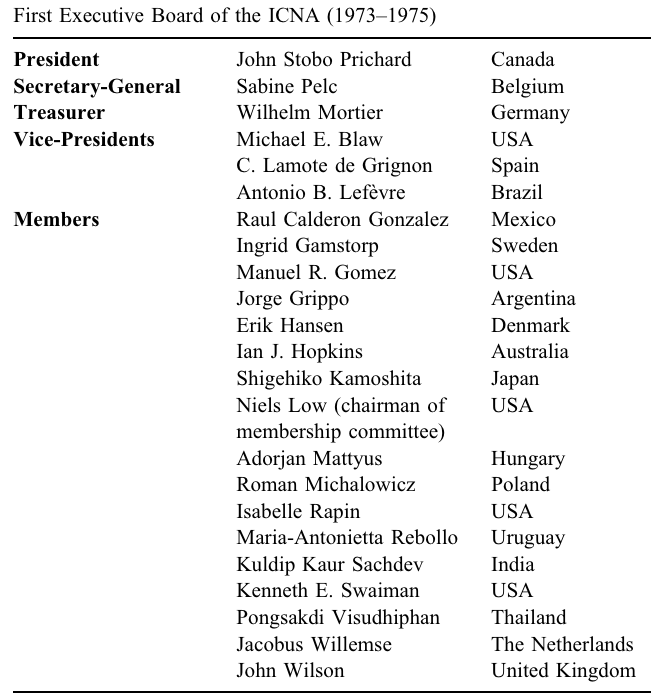 Table 1. First Executive Board of the ICNA
Table 1. First Executive Board of the ICNACongresses
Dr. Prichard organized and presided at the first ICNA Congress on October 6–10, 1975 in Toronto (Table 2). The dates were selected so as to follow the meeting of the United States Child Neurology Society on October 3–4 in Hamilton Ontario, to coincide with the meeting of the Canadian Association of Child Neurology, and to overlap with the International Society for Paediatric Neurosurgery, with a joint symposium on ‘The neurosciences and the quality of life’, ‘Brain death in infancy and childhood’, and ‘Behavior disorders in childhood: their treatment’ on October 8.
There were also two satellite meetings: the 2nd Canadian Sandoz Headache symposium on October 4 and joint meetings on October 6 and 7 with the International Brain Research Organization on ‘Developmental neurobiology’ and ‘Brain dysfunction in infantile febrile convulsions’. Meeting in conjunction with sister organizations, which was inaugurated in Toronto, was to be repeated in many future ICNA Congresses and yearly Board meetings (Table 3).
Dr. Sigvald Refsum of Norway attended this first congress as representative of the World Federation of Neurology and Dr. Thomas Stapleton of Australia as representative of the International Paediatric Association. Dr. Sven Brandt of Denmark delivered the Hospital for Sick Children Centennial Lecture: ‘The parentage of child neurology’. Dr. Henri Gastaut, who was to deliver a plenary lecture on the Lennox–Gastaut syndrome, was unable to attend due to illness. Other symposia with invited speakers included neonatal neurology and learning disabilities.
Proceedings of the symposia were published as ‘Topics in Child Neurology’ edited by Dr. Michael Blaw and colleagues in 1977, and as ‘Brain Dysfunction in Infantile Febrile Convulsions’ edited by Drs. M.A.B. Brazier and F. Cocceani (Table 4). Some 135 free papers and posters were presented. Dr. Masaya Segawa and colleagues from Tokyo described a new variant of childhood dystonia which was going to become known as dystonia with diurnal fluctuations or Segawa disease. A novelty for the time was a wine and cheese reception during the poster session of the first evening, scheduled not to coincide with any other activity so as to give all attendees the opportunity to meet and chat.
There were also elegant dinner receptions for foreign delegates at the homes of Tor-onto colleagues. Papers were presented in English, with some simultaneous translations into French and Spanish, including pinch hitting by Dr. Walter Chuquisengo Marti-nez from Peru, at the time a fellow in child neurology at Albert Einstein College of Medicine in New York. Some posters were submitted in French or Spanish.
The attendance was 800. Dr. Prichard commissioned a medal (Fig. 3) from a local artist to commemorate the Congress. Dr. Niels Low of New York was elected President of ICNA (Fig. 4) and other ICNA officers are listed in Table 5.
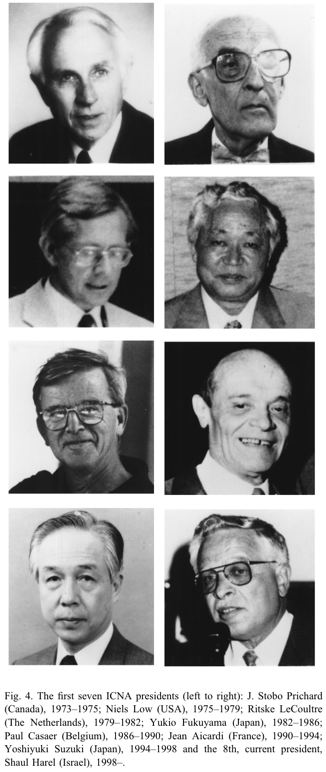
The second ICNA congress took place on November 26–30, 1979 in Sydney, Australia. Dr. Robert Ouvrier was President of the Congress and Dr. Peter Procopis, both of Australia, Chairman of the Scientific Program Committee (Table 2). It was preceded by the Second International Symposium on Learning Disabilities in Tokyo, presided by Dr. Yukio Fukuyama. The Douglas Reye Memorial Lecture was delivered by Dr. David B. Clark, of Lexington KY, USA on the topic ‘Douglas Reye and the neuropathology of childhood: their place in the neurosciences’.
The other keynote speakers were Dr. A.C. Pollard from Adelaide: ‘Enzymological diagnosis and phenotypic variability of the storage disorders affecting the central nervous system’, Dr. Carleton Gajdusek, future Nobel laureate from the NIH: ‘Neurovirology foci of high incidence in the Western Pacific’, and Dr. Werner Isler from Zurich: ‘Cerebrovascular disease in childhood’. There were symposia on neuromuscular diseases, epilepsy, pediatric neuro-ophthalmology and neurotransmitters.
Our Australian colleagues Dr. B. Wise and others edited the proceedings in a second volume of Topics in Child Neurology (Table 4). Dinner receptions at the homes of local hosts were again featured, with a resultant crisis when the number of chairs at the home of Dr. Ouvrier was inadequate for his contingent of guests who are more likely to remember the size and succulence of Australian prawns. Delegates may also remember that buses carrying them to a formal reception were too tall to enter the hallowed gates of the University.
Trips to the zoo to gaze at koalas and kangaroos (alias joeys), and to shops selling wooden sculptures from New Guinea did not discourage 400 delegates from attending the meetings. Dr. Ritske LeCoultre of the Netherlands was elected President of ICNA (Table 5, Fig. 4).
Copenhagen was the venue of the third ICNA congress on May 24–29, 1982 (Table 2). The President of the Con-gress was Dr. Erik Hansen who had previously received the Board on the Island of Fyn where it visited the home of Hans Christian Andersen. The ICNA was honored by the presence of Queen Ingrid of Denmark who opened the congress. A reception in the Tivoli Gardens was a big attraction, as was a performance of the Royal Danish Ballet in an elegant 18th century theater in the round.
Flocks of Danes on bicycles in the streets of Copenhagen prepared me for the 1984 sight of flocks of Chinese in the streets of Beijing. At this congress the ICNA awarded the first Frank R. Ford Memorial Lectureship to honor an ICNA member for exceptional contribution to child neurology, an honor which has been conferred at each succeeding ICNA congress (Table 6). The first recipient was Dr. Sabine Pelc for her singlehanded efforts to start ICNA. Her topic was the childhood leukodystrophies.
The inaugural volume of the ‘International Review of Child Neurology Series’ (Table 7), founded and edited by Dr. Prichard, was about to appear. A gauge of the future success of the series is that one of two preliminary copies of the first volume rushed to the congress, bound in light blue rather than the familiar burnt orange, was purloined on the first day of the congress. Major topics of the congress were disturbances of cortical function, head injuries, neuropharmacology, disorders of carbohydrate metabolism and nutrition, and perinatal neurology – haemodynamic events. The presidency of ICNA passed on to Dr. Yukio Fukuyama of Tokyo (Table 5, Fig. 4).
The fourth ICNA congress, on March 16–20, 1986, took place in Jerusalem, concurrently with the Satellite Symposium on Child Neurology and Developmental Pediatrics (‘Sharing Issues of Mutual Concern’) sponsored by the Hackensack (New Jersey) Medical Center’s Institute for Child Development on March 21. Dr. Shaul Harel of Tel Aviv was Congress President, Joseph H. French of the USA Chairman of the Scientific Program Committee, and Marvin I. Gottlieb of the USA chair of the satellite symposium. The congress took place during an interval of lessened tension between the Israelis and Palestinians, making it possible to visit the Old City, Jericho and the West Bank.
Dr. Prichard, who was to be Ford Lecturer, was too ill to attend but provided a stirring video of his lecture: ‘Who is a child neurologist?’. Symposia on ‘Genetic and acquired pediatric encephalopathies’, ‘Epilepsy and the developing brain’, ‘Pediatric neurologic diseases with ultrastructural pathology’, ‘Assessment and remediation of young children with central nervous system dysfunction’ were followed each day by free papers and posters on these and other themes. The ensuing publication was edited by Dr. French and others (Table 4). Paul Casaer of Leuven, Belgium, was elected the 5th president of the ICNA (Table 5, Fig. 4).
Opening ceremonies by royalty were repeated at the fifth ICNA congress in Tokyo, on November 5–9, 1990, as Prince Akishino and Princess Kiko addressed a crowd of some 900 delegates in a very large hall with three screens. Those who had the privilege of speaking to the imperial couple before the opening learned that the utterly charming Princess spoke excellent English and had a special interest in handicapped children. The ICNA congress was a joint meeting with the 3rd Asian and Oceanian Congress of Child Neurology, under the presidency of Dr. Yukio Fukuyama (Table 2), with Dr. Shigehiko Kamoshita as Chairman of the Program Committee. The Tokyo congress was the occasion for the first John Stobo Prichard Award for a child neurologist under age 45 established by Dr. Prichard’s children in his honor (Table 6).
The 1990 awardee was Dr. Michael V. Johnston, from Baltimore, whose topic was ‘Psychological and physiological roles for excitatory amino acids in central nervous system development’. The topic of the Frank Ford Memorial Lecture was ‘Autism as a neurological disorder’. Topics of plenary lectures were ‘Molecular genetics in child neurology’ delivered by the ICNA’s future 7th president, Dr. Yoshiyuki Suzuki of Tokyo, ‘Peroxisomes and pediatric neurological disorders’ by Dr. Hugo Moser of Baltimore, chairman of the Program Committee for the 1998 Ljubljana congress, ‘Fetal neuropathology’ by Dr. Fusahiro Ikuta of Niigata, ‘AIDS and the CNS in children’ by Dr. Leon Epstein of Newark, NJ, USA, ‘Plasticity and response of the immature brain to injury’ by Dr. Harvey Sarnat of Calgary, Canada, ‘Peripheral neuropathy in childhood’, by Dr. Robert Ouvrier of Sydney, topic of a future ICNA monograph. Sixteen symposia, presented simultaneously in groups of three because the meeting was so large, 329 posters, 129 free papers, 29 audiovisual presentations, and eight luncheon seminars covered all aspects of child neurology.
Simultaneous Japanese/English translation was flawless. The proceedings appeared in two volumes: ‘Modern Perspectives in Child Neurology’ and ‘Fetal and Neonatal Neurology’ edited by Dr. Fukuyama and colleagues (Table 4). Highlights of the congress were several elegant parties with ladies in brilliant kimonos in attendance, large ice statues to decorate the halls, and superlative food. Dr. Jean Aicardi of France became the 6th ICNA president (Table 5, Fig. 4), the fitting choice of one of the most peripatetic child neurolo-gists the world has yet seen, thanks in part to his prowess in multiple languages and to the fact that his retirement from the Hoˆpital des Enfants Malades in Paris gave him the freedom to serve as Visiting Professor in London, Miami, Sydney and elsewhere and to visit all the continents one or more times during his presidency.
Is it because Dr. Aicardi and Dr. Natalio Fejerman share a common November 8 birthday that an interim 6th ICNA congress was organized in Buenos Aires by Dr. Fejerman on November 8–13, 1992, to coincide with the first Iberoamerican Congress of Pediatric Neurology? The venue of the congress was opposite a park with the most beautiful blue spring (yes, we were again in the southern hemisphere) flowering trees that adorned the cover of the program. Once again posters and free papers followed plenary symposia whose proceedings were published under the editorship of Dr. Fejerman and colleagues as ‘New Trends in Pediatric Neurology’; and the proceedings of the satellite symposium on autism of November 14 was published in Spanish as ‘Autismo Infantil y Otros Trastornos del Desar-rollo’ edited by Dr. Fejerman and others (Table 4).
The Prichard Award went to Dr. Bwee Tien Poll-The´ of The Netherlands who discussed peroxisomal diseases, and the topic of the Frank Ford Memorial Lecture delivered by Dr. Yukio Fukuyama was an overview of congenital muscular dystrophy. The last day was devoted to the Iberoamerican Congress during which most papers were delivered in Spanish, including one by ICNA president Aicardi on ‘Child neurology at the end of the century: a new world and its challenges’. The Iberoamerican Academy of Pediatric Neurology founded in 1992 has been publishing Acta Neuropediatrica since 1994. This journal is unique in that every article appears in both Spanish and English. Its current distribution is to almost 3000 readers.
The 7th congress, on October 2–8 1994 in San Francisco, provided the opportunity for the first joint meeting of the ICNA with the Child Neurology Society. The President of the Congress was Dr. David Stumpf of Chicago. The Chairman of the ICNA Program Committee was Dr. Darryl De Vivo of New York and the Chairman of the CNS Program Committee was Dr. Michael Johnston of Baltimore. They worked out an integrated program so that the 1200 child neurologists and members of other disciplines from around the world had the opportunity to listen to the ICNA Presidential Symposium ‘A perspective on childhood epilepsies’ organized by Dr. Aicardi, the CNS Presidential Symposium ‘Development of the cerebral cortex – modern neurobiological perspectives’ organized by Dr. Joseph Volpe of Boston, the Decade of the Brain Plenary Symposium concerned with neurogenetics, the ontogeny of receptor systems and brain vulnerability, growth factors in brain development, the importance of neuroimaging in understanding brain development and mitochondrial genetics and human diseases.
The Frank Ford Lecturer was Dr. Philip R. Dodge of St Louis who recounted some autobiographical reminiscences. Dr. Hugo Moser, a former colleague of Dr. Dodge at Harvard, received the Hower Award of the CNS and lectured on ‘Adrenoleukodystrophy: genetics, patho-physiology and therapy’. The John Stobo Prichard Award went to Dr. Najoua Miladi of Tunisia whose title was ‘Epidemiology of child inherited neurological diseases with metabolic basis in Tunisia’ and the CNS Young Investigator awardee was Dr. Mia M. McCollin of Boston who discussed the ‘Molecular analysis of the neurofibromatosis II tumor suppressor’. Dr. David Prince of Palo Alto, CA, delivered the Bernard Sachs lecture of the CNS on ‘Epilepsy and the immature brain’. There were a total of nine other symposia and 472 posters and platform presentations. A dinner cruise on the San Francisco bay was a success despite pouring rain, fortunately without big enough waves to make anyone sea-sick. Dr. Yoshiyuki Suzuki, the only officer to have served both as Treasurer and Secretary General was elected President (Table 5, Fig. 4).
The ICNA has taken chances with the venues of its congresses: Buenos Aires, an extra congress between the 1990 and 1994 congresses, and Sydney were predicted to be too far away to attract many members, and Jerusalem was deemed to be too dangerous, yet all three congresses were well attended. The 25th anniversary of ICNA and 8th ICNA congress took place September 13–17, 1998 in Ljubljana, Slovenia, the only peaceful country to emerge from the former war-torn Yugoslavia. Again, gloomy predictions turned out to be false as there were some 920 attendees from all continents, including the largest number to date of child neurologists from the former USSR and other countries of Eastern Europe.
The Chairman of the Program Committee, Dr. Hugo Moser, arranged a rich fare of symposia, plenary sessions, platform papers, and posters covering every aspect of our field. Dr. Jean Aicardi delivered the Frank Ford Memorial Lecture ‘Epilepsy, the hidden part of the iceberg’, and the John Stobo Prichard Award reci-pient was Dr. Ingrid Tein from Toronto who spoke on ‘The impact of fatty acid oxidation disorders in child neurology’. Two important sessions highlighted the dire need for such simple treatments as epilepsy of children in Africa and other countries with social dislocation, poverty and extremely young populations. A review in pictures of the first 25-years of the ICNA was part of the opening ceremony and Dr. N. Paul Rosman of Boston closed the congress with a spectacular illustrated history of child neurology from Hippocrates to the present.
A first was that, thanks to electronic publishing, the congress proceedings ‘New Developments in Child Neurology’, edited by the congress president, Dr. Milovoj Velickovic Perat, were available at the meeting as a fat book with a lovely view of Ljubljana on the cover. The congress was superbly organized and graced by a thrilling classical concert and by folk dancers and other entertainment. Satellite symposia in London, Venice, Ljubljana, Bled, Vienna, Budapest and Istanbul considered topics ranging from modern methods of investigation in child neurology and neuromuscular disorders to Rett syndrome, rehabilitation, and pediatric behavioral neurology.
Judging from ICNA membership, which may not be a reliable gauge of the actual number of child neurologists in various countries, the disparity among countries is shocking as the fewest are to be found in the parts of the world with the largest populations of children, a distribution clearly correlated with affluence rather than need.
Publications
Nine books containing proceedings of ICNA symposia and plenary lectures have appeared (Table 4). These cover a broad range of topics, from developmental disabilities and their management to disorders of cellular organelles, molecular biology, brain development, and the childhood epilepsies, to name a few. In addition, ICNA members from many countries have written textbooks of child neurology in the languages of their countries. I have been privileged to see several of them which are major, up-to-date works that compare favorably with the most popular medical textbooks published anywhere.
The ICNA Board has held many discussions about sponsoring one of the child neurology journals, but thus far has opted instead to publish a series of topical monographs (Table 7). Dr. Prichard was the founding editor of the International Review of Child Neurology Series. Dr. Peter Procopis of Sydney, Australia succeeded him in 1986. The books were published first by Raven Press of New York, and since 1998 by Mac Keith Press of London. Dr. Prichard stated in the preface to the first volume 'we hope to present the best in child neurology wherever that may be found' (p. vii, 1982).
A total of 12 volumes have appeared since 1982 and three more are nearing publication. Each volume is peer reviewed, covers a particular topic authoritatively, and goes to all ICNA members as part of their dues, insuring immediate worldwide dissemination. In addition, some free books have been sent to the libraries of a medical school in coun-tries where financial hardship prevents members from being dues-paying. The possibility of making future monographs available electronically so as to increase their impact may need to be discussed with the publisher.
Two books, the Aicardi volume on childhood epilepsy and the Cohen and Duffner volume on brain tumors became such classics as to require second editions, and a second edition of the Ouvrier volume on peripheral neuropathy is about to appear. One of the strengths of the ICNA monographs is that some have addressed topics inadequately covered in the child neurology literature such as the neurological complications of systemic diseases, spinal cord tumors and, in a forthcoming book, pediatric movement disorders.
Other activities
There is no doubt that the ICNA has played a major role in bringing child neurology as a distinct specialty to the forefront worldwide. Many countries have adopted formal training standards and, although these differ in detail, all countries accept the need, in addition to general pediatric training, for training in the classical neurologic syndromes of adults and children and in the use of the modern clinical tools of neurological investigation as they apply to children. In addition, all emphasize the requirement of familiarity with brain and functional maturation and with the develop-mental disorders of cognition and behavior.
A number of countries now have formal specialty board examinations in child neurology. There have been quantum leaps over the past quarter of a century in the research on brain development and the diseases of the immature brain, and the ICNA can take pride in having been among those highlighting this need.
ICNA has agreed to sponsor regional child neurology meetings, provided the organizers invite an ICNA Board member and provided the scientific level of the meeting is high. The invitation from Dr. Schulte from Germany to Drs. Ingrid Gamstorp from Sweden and Niels Low from the USA, then President and Secretary General of ICNA, to attend the 1977 meeting of the Federation of European Child Neurology Societies did much to convince European child neurologists to join ICNA. In 1978, Drs. Low and Erik Hansen from Denmark represented the ICNA at a meeting of the Purkinje Society in Prague, chaired by ICNA member Dr. Ivan Lesny, at which Dr. Low and a Russian, Dr. Ratner, were awarded medals.
Dr. Hansen was invited to dinner at the house of Dr. Lehovsky, another Czech ICNA member, while Dr. Low, invited by Dr. Lesny, found out that he had lived for a year in Copenhagen as a child so they were able to converse in Danish, Dr. Low's native tongue. Drs. Rapin and Manuel Gomez of the USA were invited in May 1982 to the ICNA-sponsored meeting of child neurologists of East-ern Europe in Bratislava, at a time when Eastern bloc countries were hungering for contact with Western science and medicine. Their need to access the medical literature, to travel to congresses and to visit child neurologists and neuroscientists in other countries was distressing, but their hos-pitality was warming.
The two Americans remember with particular pleasure an evening at an inn in the Small Carpathian Mountains where they had a chance to meet Dr. Boris Lebedev from Moscow who had spent some time training in the UK, spoke excellent English, and was full of amusing stories. His informality contrasted markedly with the more formal appearance of Dr. Levon Badaljan, an academician also from Moscow, who attended several early ICNA congresses flanked by a bodyguard.
A few national and regional child neurology societies are older than ICNA. Among them, the Japanese Society of Child Neurology was founded in 1961; the Federation of European Child Neurology Societies in 1970; the Child Neurology Society of the USA in 1972. Yet there is little doubt that ICNA has had an impact on the development of regional child neurology associations. The Iberoamerican Society of Child Neurology started with flying colors in 1992 by inviting the ICNA to share in its inaugural congress by hosting an interim meeting in Buenos Aires under the presidency of Dr. Natalio Fejerman.
The Asian and Oceanian Association of Child Neurology (AOACN) was founded in Taiwan in 1983 with Dr. Yu-Zen Shen as President. Its second meeting in Jakarta in 1987, under the presidency of Dr. Hendarto, took place under ICNA spon-sorship and was attended by a number of ICNA members from outside the region. I particularly enjoyed the visit arranged for attendees at a national museum where a large screen film introduced foreigners to the beauty and great diversity of this island nation. The third AOACN congress in 1990 was a joint meeting with ICNA in Tokyo.
I was also privileged to attend the fourth, in Chiang Mai, Thailand in 1993, under the presidency of founding ICNA member Dr. Pongsakdi Visudhiphan, who trained in child neurology at Albert Einstein in New York. The congress was attended by delegates from six countries outside the region, including among the ICNA members Dr. Aicardi from France, Dr. Logan from Canada and Dr. Kolodny from the USA. A visit to the fascinating night market did not interfere with attendance at the high quality meeting which included seven plenary lectures and symposia on neurodegenerative dis-eases, epilepsy and infection.
A well attended 5th congress took place in Istanbul in 1996 under the presidency of Dr. Yavuz Renda. There is now a Baltic Child Neurology asso-ciation which invited the ICNA Board to hold its 1995 meet-ing in Palanga, Lithuania where it was holding its second congress. The most recent regional child neurology society is the Paediatric Neurology and Development Association of South Africa (PANDA) which invited the ICNA Board to share its first meeting in Cape Town in 1997.
Conclusion and future perspectives
Dr. Sabine Pelc and Dr. John Stobo Prichard, the founding mother and father of ICNA, would be proud, had they not both died prematurely, to see the vigor of the child they brought into the world. New generations of child neurologists are replacing the old guard who were young when they started the society. ICNA is now well established and has members in all continents, albeit in disproportionately small numbers in Africa, in countries of the former Soviet Union and Eastern Europe, and mainland Asia.
It is well on its way to fulfilling its goals of bettering the care of children with neurologic diseases, of helping set standards for training, of fostering research and high quality education through congresses, publications, and personal contact among child neurologists, of promoting collegiality and sharing of infor-mation and resources among the child neurologists of the world, of encouraging the development of regional child neurology associations, and of enhancing the visibility of child neurology as a specialty. One of the strongest needs for the future is to spread information in the less affluent countries where the care of children with neurologic diseases and developmental handicaps lags.
Teaching visits, donation of books and training to increase access to the neurologic resources of the Internet – including the exchange of information about the care of difficult cases provided by the Child Neurology Bulletin Board, and no doubt others efforts, are some of the ways the ICNA has at its disposal to contribute to correcting these disparities and achieving the goals set by its founders.
Acknowledgements
Writing this history of ICNA would have not been possible without the gracious help of the many members who generously shared information, sent pictures and documents, answered my many questions, and whom I thank most cordially. I thank especially Drs. Yoshiyuki Suzuki, Niels Low, Robert Ouvrier, Natalio Fejerman, Henri Szli-wowski and Jean Aicardi whom I pestered repeatedly and who provided particularly crucial material. I also thank Ms Mary Currey of the Child Neurology Society for informa-tion on the CNS and Mr Howard Rubin for photography.
I consulted the helpful papers by Dr. Sven Brandt in the 1977 Topics in Child Neurology, p. 3 on the parentage of child neurology and by Dr. David Stumpf in the Bulletin of the NY Academy of Medicine, 1981;57:804–816, on the founding of pediatric neurology in America, as well as the encyclopedic book The Founders of Child Neurology edited by Dr. Stephen Ashwal, San Francisco, Norman Publishers, 1990.
Isabelle Rapin
Join Our Newsletter
Why Join the ICNA?

